Analysis of Hofstede's Cultural Dimensions in Organizational Culture
VerifiedAdded on 2020/10/05
|6
|1212
|464
Essay
AI Summary
This essay delves into Hofstede's cultural dimensions, including individualism/collectivism, power distance, uncertainty avoidance, and masculinity/femininity, and their effects on organizational culture. It begins by defining organizational culture and its influence on employee behavior, communication, and decision-making. The main body of the essay evaluates the dimensions of Hofstede's model, discussing how each dimension impacts organizational culture. The essay agrees that collectivism, high power distance, and high uncertainty avoidance are beneficial. Furthermore, the essay suggests that collectivism should be introduced to bring people together, high power distance to maintain decorum, high uncertainty avoidance to avoid risks, and feminism to avoid differentiation. The essay concludes by summarizing the discussed dimensions and suggestions for improving organizational culture. The essay provides a detailed analysis of how these dimensions can shape the environment and outcomes within an organization.
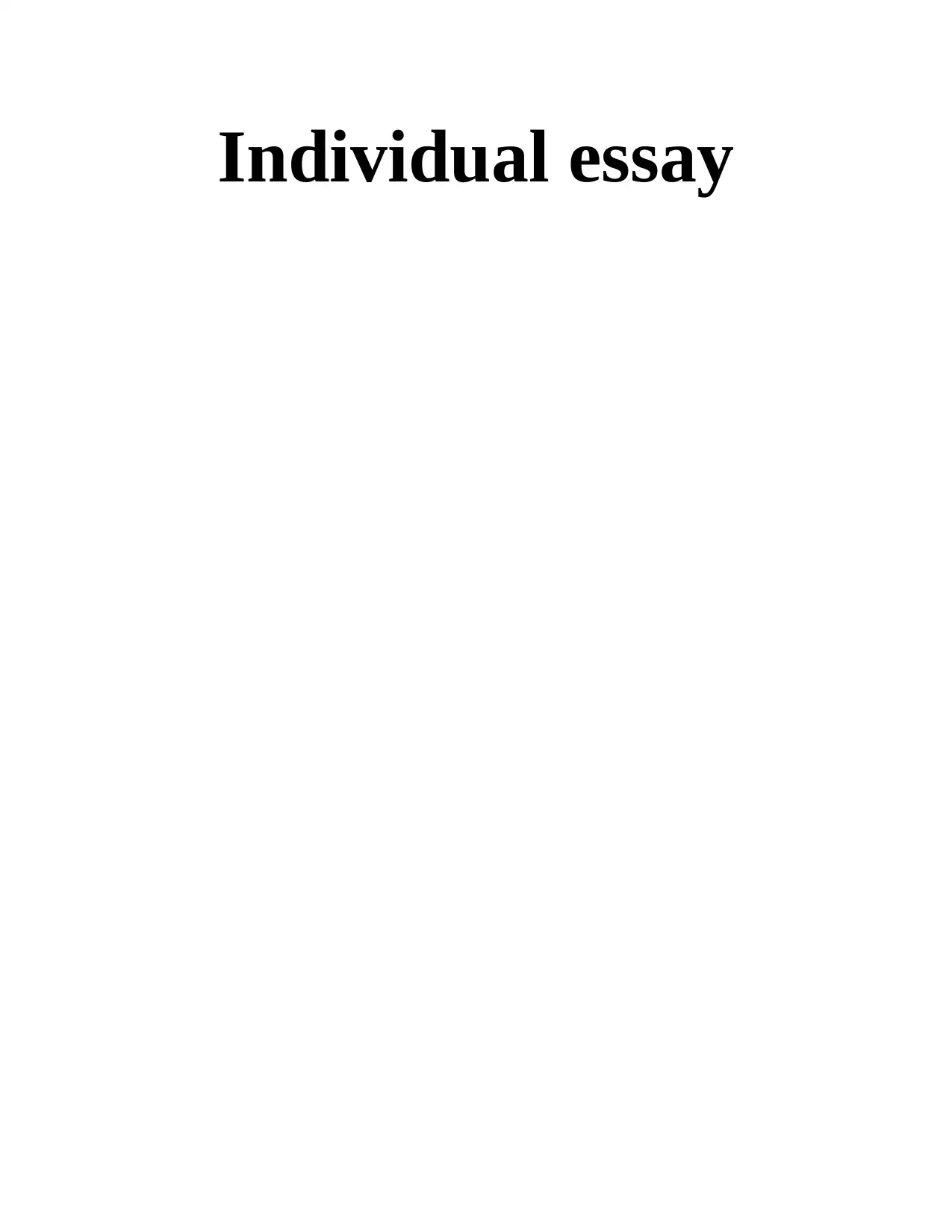
Individual essay
Paraphrase This Document
Need a fresh take? Get an instant paraphrase of this document with our AI Paraphraser
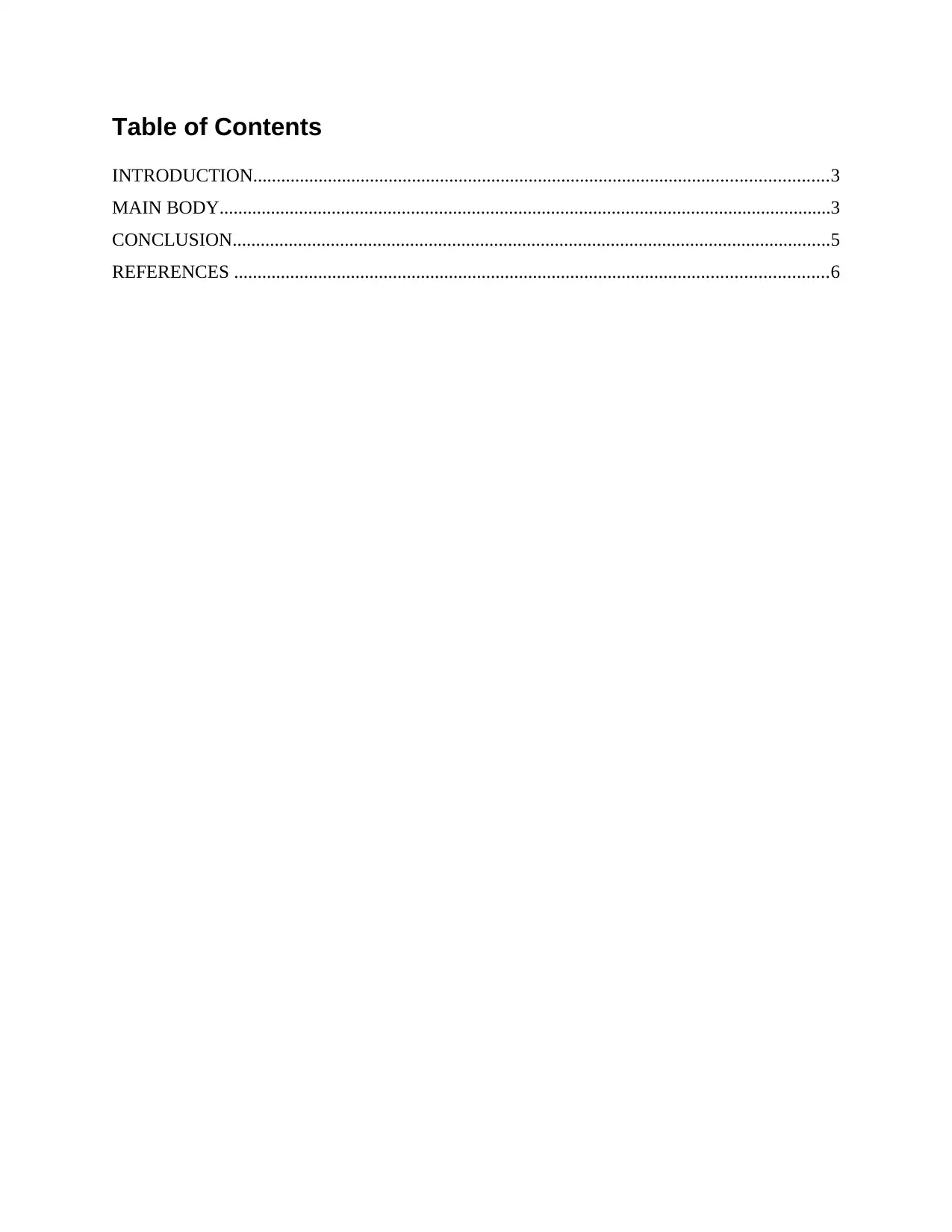
Table of Contents
INTRODUCTION...........................................................................................................................3
MAIN BODY...................................................................................................................................3
CONCLUSION................................................................................................................................5
REFERENCES ...............................................................................................................................6
INTRODUCTION...........................................................................................................................3
MAIN BODY...................................................................................................................................3
CONCLUSION................................................................................................................................5
REFERENCES ...............................................................................................................................6
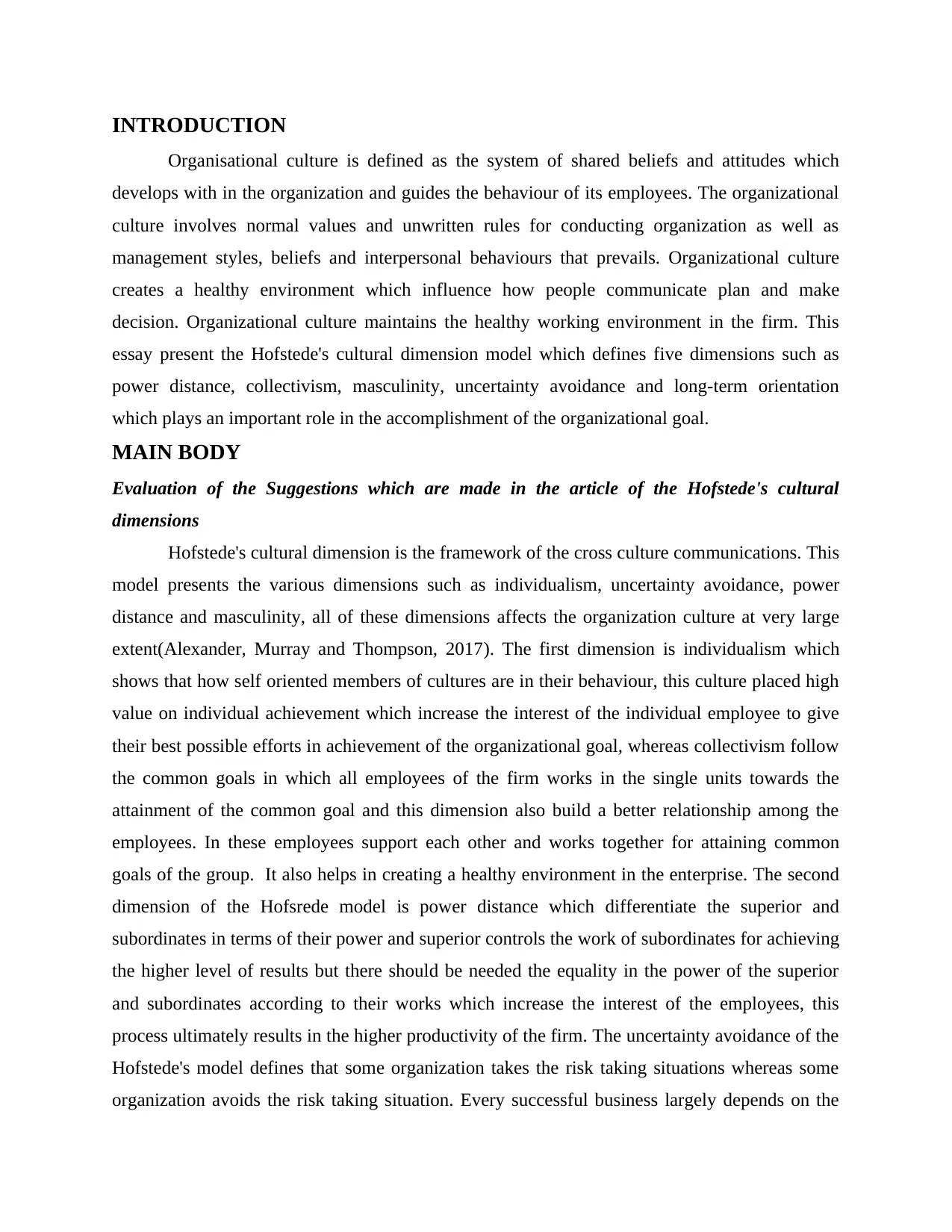
INTRODUCTION
Organisational culture is defined as the system of shared beliefs and attitudes which
develops with in the organization and guides the behaviour of its employees. The organizational
culture involves normal values and unwritten rules for conducting organization as well as
management styles, beliefs and interpersonal behaviours that prevails. Organizational culture
creates a healthy environment which influence how people communicate plan and make
decision. Organizational culture maintains the healthy working environment in the firm. This
essay present the Hofstede's cultural dimension model which defines five dimensions such as
power distance, collectivism, masculinity, uncertainty avoidance and long-term orientation
which plays an important role in the accomplishment of the organizational goal.
MAIN BODY
Evaluation of the Suggestions which are made in the article of the Hofstede's cultural
dimensions
Hofstede's cultural dimension is the framework of the cross culture communications. This
model presents the various dimensions such as individualism, uncertainty avoidance, power
distance and masculinity, all of these dimensions affects the organization culture at very large
extent(Alexander, Murray and Thompson, 2017). The first dimension is individualism which
shows that how self oriented members of cultures are in their behaviour, this culture placed high
value on individual achievement which increase the interest of the individual employee to give
their best possible efforts in achievement of the organizational goal, whereas collectivism follow
the common goals in which all employees of the firm works in the single units towards the
attainment of the common goal and this dimension also build a better relationship among the
employees. In these employees support each other and works together for attaining common
goals of the group. It also helps in creating a healthy environment in the enterprise. The second
dimension of the Hofsrede model is power distance which differentiate the superior and
subordinates in terms of their power and superior controls the work of subordinates for achieving
the higher level of results but there should be needed the equality in the power of the superior
and subordinates according to their works which increase the interest of the employees, this
process ultimately results in the higher productivity of the firm. The uncertainty avoidance of the
Hofstede's model defines that some organization takes the risk taking situations whereas some
organization avoids the risk taking situation. Every successful business largely depends on the
Organisational culture is defined as the system of shared beliefs and attitudes which
develops with in the organization and guides the behaviour of its employees. The organizational
culture involves normal values and unwritten rules for conducting organization as well as
management styles, beliefs and interpersonal behaviours that prevails. Organizational culture
creates a healthy environment which influence how people communicate plan and make
decision. Organizational culture maintains the healthy working environment in the firm. This
essay present the Hofstede's cultural dimension model which defines five dimensions such as
power distance, collectivism, masculinity, uncertainty avoidance and long-term orientation
which plays an important role in the accomplishment of the organizational goal.
MAIN BODY
Evaluation of the Suggestions which are made in the article of the Hofstede's cultural
dimensions
Hofstede's cultural dimension is the framework of the cross culture communications. This
model presents the various dimensions such as individualism, uncertainty avoidance, power
distance and masculinity, all of these dimensions affects the organization culture at very large
extent(Alexander, Murray and Thompson, 2017). The first dimension is individualism which
shows that how self oriented members of cultures are in their behaviour, this culture placed high
value on individual achievement which increase the interest of the individual employee to give
their best possible efforts in achievement of the organizational goal, whereas collectivism follow
the common goals in which all employees of the firm works in the single units towards the
attainment of the common goal and this dimension also build a better relationship among the
employees. In these employees support each other and works together for attaining common
goals of the group. It also helps in creating a healthy environment in the enterprise. The second
dimension of the Hofsrede model is power distance which differentiate the superior and
subordinates in terms of their power and superior controls the work of subordinates for achieving
the higher level of results but there should be needed the equality in the power of the superior
and subordinates according to their works which increase the interest of the employees, this
process ultimately results in the higher productivity of the firm. The uncertainty avoidance of the
Hofstede's model defines that some organization takes the risk taking situations whereas some
organization avoids the risk taking situation. Every successful business largely depends on the
⊘ This is a preview!⊘
Do you want full access?
Subscribe today to unlock all pages.

Trusted by 1+ million students worldwide
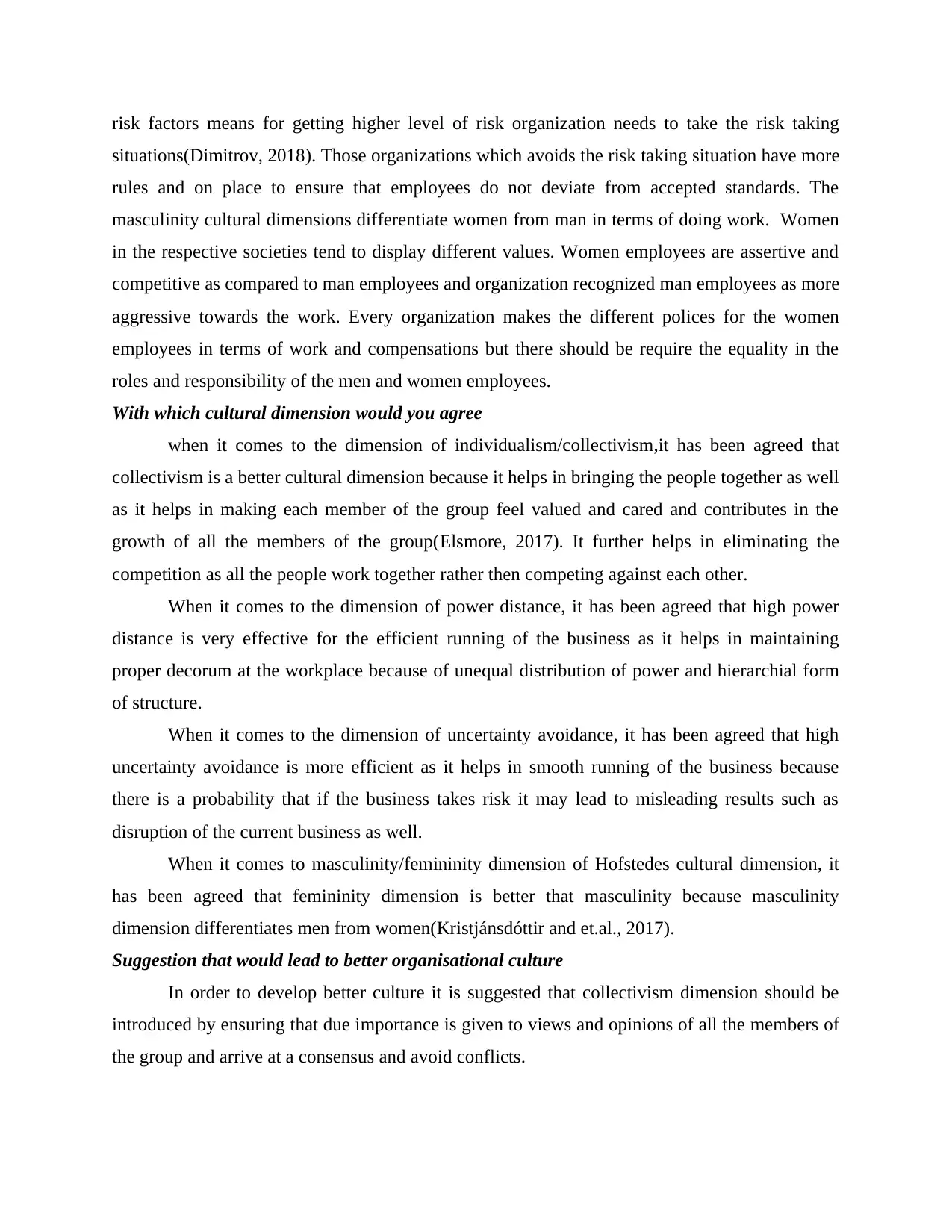
risk factors means for getting higher level of risk organization needs to take the risk taking
situations(Dimitrov, 2018). Those organizations which avoids the risk taking situation have more
rules and on place to ensure that employees do not deviate from accepted standards. The
masculinity cultural dimensions differentiate women from man in terms of doing work. Women
in the respective societies tend to display different values. Women employees are assertive and
competitive as compared to man employees and organization recognized man employees as more
aggressive towards the work. Every organization makes the different polices for the women
employees in terms of work and compensations but there should be require the equality in the
roles and responsibility of the men and women employees.
With which cultural dimension would you agree
when it comes to the dimension of individualism/collectivism,it has been agreed that
collectivism is a better cultural dimension because it helps in bringing the people together as well
as it helps in making each member of the group feel valued and cared and contributes in the
growth of all the members of the group(Elsmore, 2017). It further helps in eliminating the
competition as all the people work together rather then competing against each other.
When it comes to the dimension of power distance, it has been agreed that high power
distance is very effective for the efficient running of the business as it helps in maintaining
proper decorum at the workplace because of unequal distribution of power and hierarchial form
of structure.
When it comes to the dimension of uncertainty avoidance, it has been agreed that high
uncertainty avoidance is more efficient as it helps in smooth running of the business because
there is a probability that if the business takes risk it may lead to misleading results such as
disruption of the current business as well.
When it comes to masculinity/femininity dimension of Hofstedes cultural dimension, it
has been agreed that femininity dimension is better that masculinity because masculinity
dimension differentiates men from women(Kristjánsdóttir and et.al., 2017).
Suggestion that would lead to better organisational culture
In order to develop better culture it is suggested that collectivism dimension should be
introduced by ensuring that due importance is given to views and opinions of all the members of
the group and arrive at a consensus and avoid conflicts.
situations(Dimitrov, 2018). Those organizations which avoids the risk taking situation have more
rules and on place to ensure that employees do not deviate from accepted standards. The
masculinity cultural dimensions differentiate women from man in terms of doing work. Women
in the respective societies tend to display different values. Women employees are assertive and
competitive as compared to man employees and organization recognized man employees as more
aggressive towards the work. Every organization makes the different polices for the women
employees in terms of work and compensations but there should be require the equality in the
roles and responsibility of the men and women employees.
With which cultural dimension would you agree
when it comes to the dimension of individualism/collectivism,it has been agreed that
collectivism is a better cultural dimension because it helps in bringing the people together as well
as it helps in making each member of the group feel valued and cared and contributes in the
growth of all the members of the group(Elsmore, 2017). It further helps in eliminating the
competition as all the people work together rather then competing against each other.
When it comes to the dimension of power distance, it has been agreed that high power
distance is very effective for the efficient running of the business as it helps in maintaining
proper decorum at the workplace because of unequal distribution of power and hierarchial form
of structure.
When it comes to the dimension of uncertainty avoidance, it has been agreed that high
uncertainty avoidance is more efficient as it helps in smooth running of the business because
there is a probability that if the business takes risk it may lead to misleading results such as
disruption of the current business as well.
When it comes to masculinity/femininity dimension of Hofstedes cultural dimension, it
has been agreed that femininity dimension is better that masculinity because masculinity
dimension differentiates men from women(Kristjánsdóttir and et.al., 2017).
Suggestion that would lead to better organisational culture
In order to develop better culture it is suggested that collectivism dimension should be
introduced by ensuring that due importance is given to views and opinions of all the members of
the group and arrive at a consensus and avoid conflicts.
Paraphrase This Document
Need a fresh take? Get an instant paraphrase of this document with our AI Paraphraser
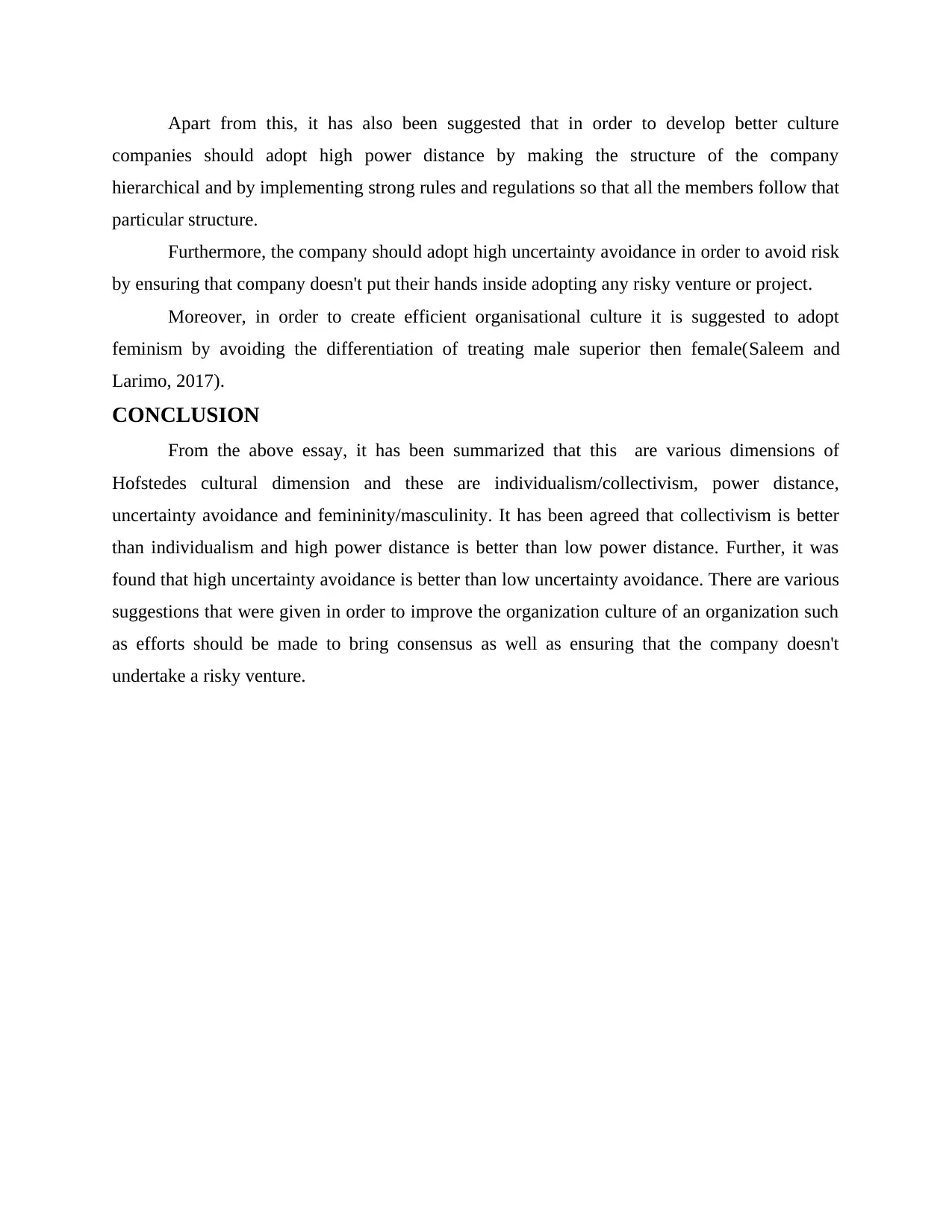
Apart from this, it has also been suggested that in order to develop better culture
companies should adopt high power distance by making the structure of the company
hierarchical and by implementing strong rules and regulations so that all the members follow that
particular structure.
Furthermore, the company should adopt high uncertainty avoidance in order to avoid risk
by ensuring that company doesn't put their hands inside adopting any risky venture or project.
Moreover, in order to create efficient organisational culture it is suggested to adopt
feminism by avoiding the differentiation of treating male superior then female(Saleem and
Larimo, 2017).
CONCLUSION
From the above essay, it has been summarized that this are various dimensions of
Hofstedes cultural dimension and these are individualism/collectivism, power distance,
uncertainty avoidance and femininity/masculinity. It has been agreed that collectivism is better
than individualism and high power distance is better than low power distance. Further, it was
found that high uncertainty avoidance is better than low uncertainty avoidance. There are various
suggestions that were given in order to improve the organization culture of an organization such
as efforts should be made to bring consensus as well as ensuring that the company doesn't
undertake a risky venture.
companies should adopt high power distance by making the structure of the company
hierarchical and by implementing strong rules and regulations so that all the members follow that
particular structure.
Furthermore, the company should adopt high uncertainty avoidance in order to avoid risk
by ensuring that company doesn't put their hands inside adopting any risky venture or project.
Moreover, in order to create efficient organisational culture it is suggested to adopt
feminism by avoiding the differentiation of treating male superior then female(Saleem and
Larimo, 2017).
CONCLUSION
From the above essay, it has been summarized that this are various dimensions of
Hofstedes cultural dimension and these are individualism/collectivism, power distance,
uncertainty avoidance and femininity/masculinity. It has been agreed that collectivism is better
than individualism and high power distance is better than low power distance. Further, it was
found that high uncertainty avoidance is better than low uncertainty avoidance. There are various
suggestions that were given in order to improve the organization culture of an organization such
as efforts should be made to bring consensus as well as ensuring that the company doesn't
undertake a risky venture.
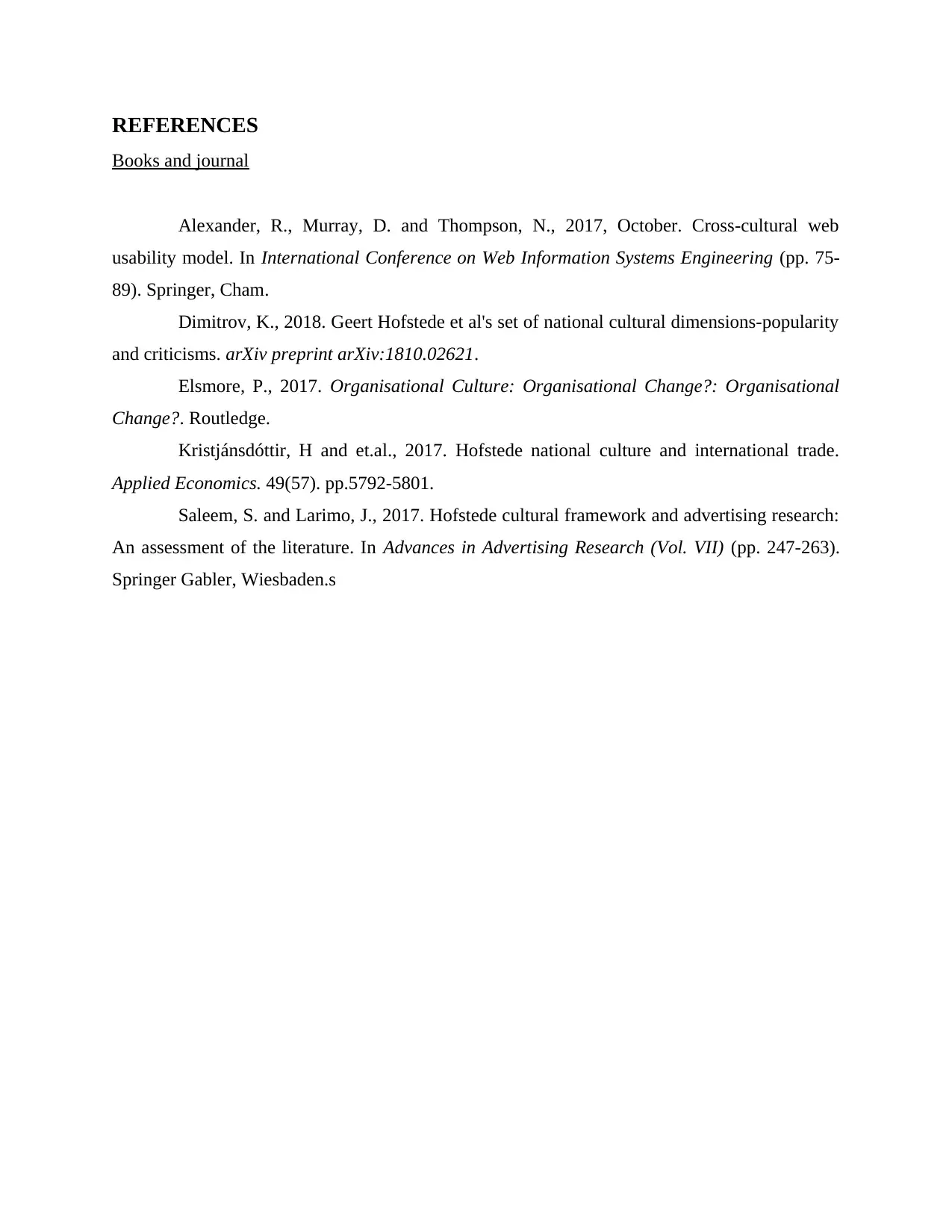
REFERENCES
Books and journal
Alexander, R., Murray, D. and Thompson, N., 2017, October. Cross-cultural web
usability model. In International Conference on Web Information Systems Engineering (pp. 75-
89). Springer, Cham.
Dimitrov, K., 2018. Geert Hofstede et al's set of national cultural dimensions-popularity
and criticisms. arXiv preprint arXiv:1810.02621.
Elsmore, P., 2017. Organisational Culture: Organisational Change?: Organisational
Change?. Routledge.
Kristjánsdóttir, H and et.al., 2017. Hofstede national culture and international trade.
Applied Economics. 49(57). pp.5792-5801.
Saleem, S. and Larimo, J., 2017. Hofstede cultural framework and advertising research:
An assessment of the literature. In Advances in Advertising Research (Vol. VII) (pp. 247-263).
Springer Gabler, Wiesbaden.s
Books and journal
Alexander, R., Murray, D. and Thompson, N., 2017, October. Cross-cultural web
usability model. In International Conference on Web Information Systems Engineering (pp. 75-
89). Springer, Cham.
Dimitrov, K., 2018. Geert Hofstede et al's set of national cultural dimensions-popularity
and criticisms. arXiv preprint arXiv:1810.02621.
Elsmore, P., 2017. Organisational Culture: Organisational Change?: Organisational
Change?. Routledge.
Kristjánsdóttir, H and et.al., 2017. Hofstede national culture and international trade.
Applied Economics. 49(57). pp.5792-5801.
Saleem, S. and Larimo, J., 2017. Hofstede cultural framework and advertising research:
An assessment of the literature. In Advances in Advertising Research (Vol. VII) (pp. 247-263).
Springer Gabler, Wiesbaden.s
⊘ This is a preview!⊘
Do you want full access?
Subscribe today to unlock all pages.

Trusted by 1+ million students worldwide
1 out of 6
Related Documents
Your All-in-One AI-Powered Toolkit for Academic Success.
+13062052269
info@desklib.com
Available 24*7 on WhatsApp / Email
![[object Object]](/_next/static/media/star-bottom.7253800d.svg)
Unlock your academic potential
Copyright © 2020–2025 A2Z Services. All Rights Reserved. Developed and managed by ZUCOL.



